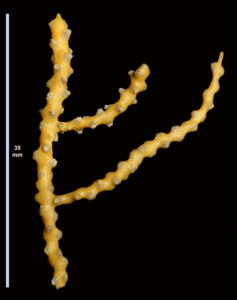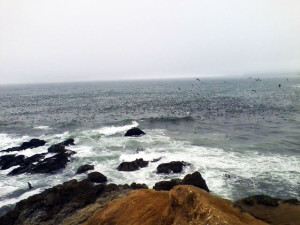On a stormy winter night in 2004, as the merchant ship Med Taipei plowed southbound off the coast of Monterey in 20- to 30-foot swells, 15 shipping containers slid into the sea. Such occurrences aren’t especially newsworthy–an estimated 10,000 containers are lost every year worldwide. But these 40-foot-long containers fell into the Monterey Bay National Marine Sanctuary (MBNMS), and sanctuary officials weren’t notified.
That summer, researchers from the Monterey Bay Aquarium Research Institute (MBARI) happened upon one of the shipping containers 4,000 feet below sea level on a slope between Monterey and Cabrillo canyons. They traced the serial number, visible on the side of the container, to the Med Taipei and identified its intact contents as 1,159 steel-belted radial tires.
A legal battle led to a $3.25 million settlement, allowing scientists to turn the incident into an opportunity to learn about the impacts of container trash in the deep ocean, an ecosystem that experts are only starting to explore. In March 2011, researchers from MBNMS and MBARI sent Doc Ricketts, a remotely operated vehicle (ROV) capable of exploring depths down to 13,000 feet, to investigate the containers’ impact on the ecosystem. MBARI, based in Moss Landing 20 miles north of Monterey, is one of just six organizations in the world that can explore the ocean at this depth. Inside the mother ship, Western Flyer, the operators manipulated Doc Ricketts’s arms by moving their own arms in mechanical braces. “If the pilots pinch lightly, the ROV can pick up a delicate sea star. Pinch hard and they can break rocks,” says MBNMS research coordinator Andrew DeVogelaere.
The scientists are concerned that the containers littering ocean floors may provide “stepping stones” for invasive species to cross from one oceanic bioregion to another. While scientists are still analyzing the samples and photos gathered during the March expedition, they do know the container is attracting creatures not found on the adjacent seafloor, including rare deep-sea scallops, flytrap anemones, and octocoral.
In addition to learning more about the effects of container trash, MBARI and MBNMS hope to add ecological concerns to the international debate about shipping container loss, which currently centers on economics and safety. “The lost containers aren’t going away,” says DeVogelaere. “We’re impacting the deep-ocean ecosystem before we even know what’s living there. There’s a beautiful seascape down there, more beautiful than people expect.”

.jpg)



